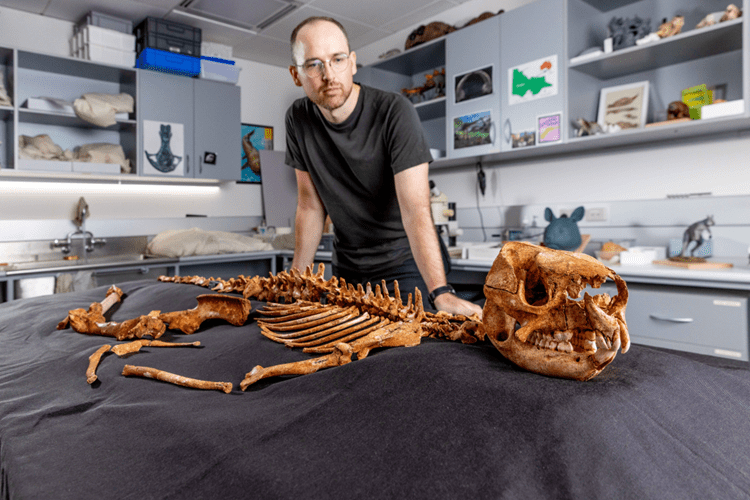The powerful jaws of an extinct species of kangaroo have emerged from the dark depths of a cave on Gunaikurnai Country near Buchan in East Gippsland.
Parks Victoria rangers have helped unearth the 50,000-year-old skeleton of the extinct short-faced kangaroo Simosthenurus occidentalis as part of a four-year project sparked by the remarkable discovery.
According to Museums Victoria, who led the excavation project, the skeleton is one of the most complete ever found in Australia.
Palaeontologist Tim Ziegler with the fossil skeleton at Museums Victoria Research Institute. Photo by Tim Carrafa. Credit: Museums Victoria
In 2011, Ranger Phil McGuinn was one of the first people to enter Nightshade Cave in recorded history, as part of a Victorian Limestone Caving Team expedition.
As a senior ranger based at the famous Buchan Caves Reserve, Phil is no stranger to the subterranean landscape of the region, and he's worked closely with caving clubs to expand knowledge of the local cave systems.
"I'd done a little caving up here from time to time and was asked to go along on this one for Parks Victoria," he says. "The team was attempting to trace an underground watersource and we'd arranged an exploration permit."
The exact location of the cave will remain confidential, to conserve its delicate condition. But like many caves in the area, getting inside requires specialist equipment and a lot of hard work.
The cavers dug open the vertical shaft of the cave, and abseiled 10 metres down inside
"It's quite exciting when you get into where nobody has ever been before," Phil says. "Once we were inside, it was a very narrow squeeze to get further – it took three hours to get two metres. The cave opened up, and we saw the skull."
The kangaroo's skeleton had lain, undisturbed, for more than 50,000 years.
"At first, we didn't realise there was more skeleton – it was buried under a rockfall," Phil says. "It was incredible. It's not the first time I've been involved with something like this – fossils and bones are found around here regularly, but this was special."
The kangaroo's skull as first seen inside the cave. Credit: Parks Victoria
The find was reported to Museums Victoria and the cave sealed back up to keep the find safe.
Museums Victoria Research Institute palaeontologist Tim Ziegler visited the cave in 2021, and noticed the fossil was starting to degrade.
Together with the Victorian Speleological Association, Ziegler began a two-year project to excavate it.
Phil and other Parks rangers helped with access to the site and logistical support.
"We were there, but Museums Victoria and the VSA did most of the work and deserve the credit."
The team descended more than 20 metres underground and squeezed through tight passages encrusted by stalactites to excavate the fossil.
"It was very awkward inside the cave – you could only have one person, contorting their arm in about three places to get to the skeleton," Phil says.
The specimen, now in the care of the Museums Victoria Research Institute, has been made available for research projects of significant global interest.
In life, it was a stocky animal that weighed more than 80 kilograms and used its powerful jaws to eat tough plant material like woody shrubs and herbs. Slower than its modern cousins, it walked rather than hopped across the landscape.
The remains of the long-extinct species have been found across Australia, but never so complete a state. The fossil has 71 per cent of its bones and includes an intact skull.
"This fossil skeleton was first seen and reported by members of local caving clubs. They've made an invaluable contribution to the natural heritage of the Buchan Caves, to the local area and to scientific knowledge worldwide," Phil says.
Ziegler and the Museums Victoria team are delighted by the discovery. "Fossils of this quality and completeness are extremely rare in Australia. This skeleton has lain in a pitch-black cave for 50,000 years, and it's been a privilege to bring it back to the light," Ziegler says.








